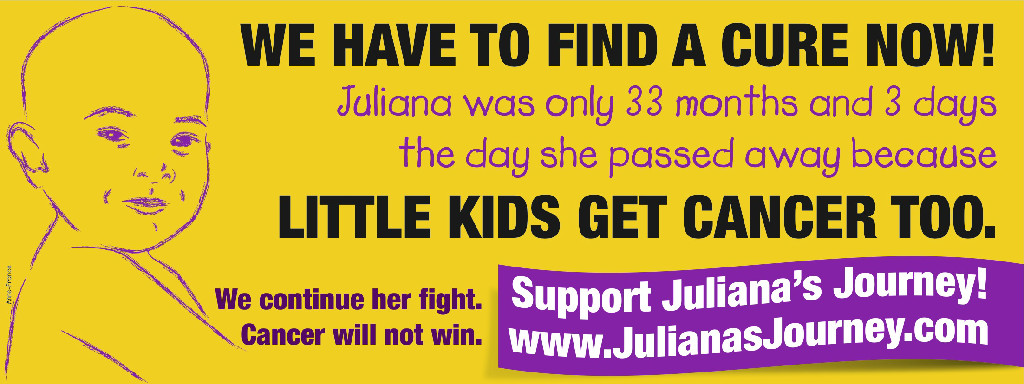
Other Childhood Cancers
Other Childhood Cancers1
Acute Lymphoblastic Leukemia (ALL) is the most common type of childhood cancer. It is a cancer of the blood and bone marrow. Normally the bone marrow makes stem cells that mature into blood cells over time. In ALL, too many stem cells turn into immature white blood cells (lymphoblasts) that don’t mature into the normal blood cells (lymphocytes) that fight infection by attacking germs and other harmful bacteria.
Central Nervous System (CNS) tumors are cancers of the brain and brain stem. They are the most common solid tumors of childhood and they have the highest mortality rate of the childhood cancers. Types include medulloblastoma, PNET, germ cell tumors, high-grade and low-grade gliomas, ependymoma, astrocytoma and more.
Clear Cell Sarcoma of the Kidney (CCSK) is a very rare type of kidney tumor. It is not recognizable as different from Wilms tumor before removal of the tumor, but requires a different treatment.
Ewing Sarcoma is a less common form of bone tumor, affecting mostly children ages five and older. These tumors form in the cavity of the bone.
Hodgkin disease is a type of lymphoma, a cancer of the lymph nodes. It affects teens most commonly, but also younger children. The lymph system is present throughout the body and helps fight infections. Hodgkin disease can start almost anywhere and then spread to almost any organ or tissue, including the liver, bone marrow and spleen.
Myeloid Leukemias are more rare and difficult to cure than the more common Acute Lymphoblastic Leukemia. In leukemia, the bone marrow produces large numbers of abnormal blood cells, which flood the bloodstream and lymph system and may invade vital organs. The most common cancer of the myeloid cells is Acute Myeloid Leukemia (AML). Others include Juvenile Myelomonocytic Leukemia (JMML), Chronic Myelogenous Leukemia (CML), Acute Promyelocytic Leukemia (APL), and Myelodysplastic Syndromes (MDS).
Non-Hodgkin’s Lymphomas (NHL) are cancers of the cells of the immune system (T and B lymphocytes, natural killer cells). Cells of the immune system are produced in the bone marrow and then travel to all the lymph glands, the thymus gland, areas of the intestinal tract, tonsils, and spleen, so a lymphoma can develop in any of those sites. The four major subtypes of NHL in children are Lymphoblastic, Burkitts, Large B cell, and Anaplastic large cell.
Osteogenic sarcoma (or Osteosarcoma) is the most frequently diagnosed type of bone tumor, usually found in adolescents and young adults. Tumors are most often in the large bones of the upper arm (humerus) and the leg (femur and tibia).
Retinoblastoma is a cancer of the retinoblasts, or "baby" cells in the retina, responsible for vision. Retinoblastoma occurs most often in children from birth to age 3. About 40% of these children have the genetic form of the disease; with every cell in the retina susceptible to tumor formation, usually both eyes are affected. The other 60% have the non-genetic type, affecting only one eye. Since removal of the eye can cure most children research is now focused on preserving vision.
Rhabdoid Tumor of the Kidney is a very rare type of kidney tumor, and rhabdoid tumors can occur in other places of the body, as well. Researchers have found a specific gene mutation that leads to rhabdoid tumors.
Rhabdomyosarcoma is the most common of the soft tissue sarcomas which can be found anywhere in the body. Rhabdomyosarcoma is a tumor that arises in the muscle cells, and is the most common type in children under age ten. The other soft tissue tumors are rarer and tend to be found in adolescents. They include fibrosarcomas, synovial sarcomas, malignant peripheral nerve tumors, leiomyosarcoma, liposarcoma, and others even more rare. Some soft tissue tumors are similar to those found in adults, while others are very unique to children.
Wilms Tumor accounts for about 90% of kidney tumors in children. About 95% of children with this tumor have a "favorable histology" (better cure rate with less treatment) as determined by the pattern the pathologist sees in the tumor cells. The other 5% have anaplastic Wilms tumor, which is much more resistant to treatment.
Other Rare Childhood Cancers are actually not so rare, when added together, as they account for about 30% of cancers diagnosed in children and adolescents. Because so few children are diagnosed with each type, however, it is very difficult to do research on these cancers. They include germ cell tumors, liver tumors (hepatoblastoma and hepatocellular carcinoma), adrenocortoco carcinoma, colon cancer, melanoma, nasalpharangyal cancer, thyroid tumors and others.
1. Supplied by St. Baldrick's Foundation · 1333 South Mayflower Avenue, Suite 400 · Monrovia, CA 91016 USA↩
Juliana's Journey Foundation
P.O. Box 246 • South San Francisco, CA 94083-0246 USA
Content copyright 2012-2014. JULIANASJOURNEY.ORG. All rights reserved.
